2020 TOYOTA PROACE VERSO tow
[x] Cancel search: towPage 158 of 418

158
Automatic operation of
hazard warning lamps
Hazard warning lamps
When braking in an emergency, depending on the rate of deceleration, as well as when the ABS regulation is invoked or in the event of an impact, the hazard warning lamps come on
automatically.They switch off automatically the first time you accelerate.F You can also switch them off by pressing the button.
Visual warning with all of the direction indicators flashing to alert other road users to a vehicle breakdown, towing or accident.
ER A - GLONASS
emergency call system*
This system allows you to make an ER A-GLONASS emergency call system to the emergency services.
For more information on Audio and telematics and in particular the
use of this equipment, refer to the corresponding section.
F Press this button, all of the direction indicators flash.They can operate with the ignition off.
* If equipped.
Safety
Page 159 of 418
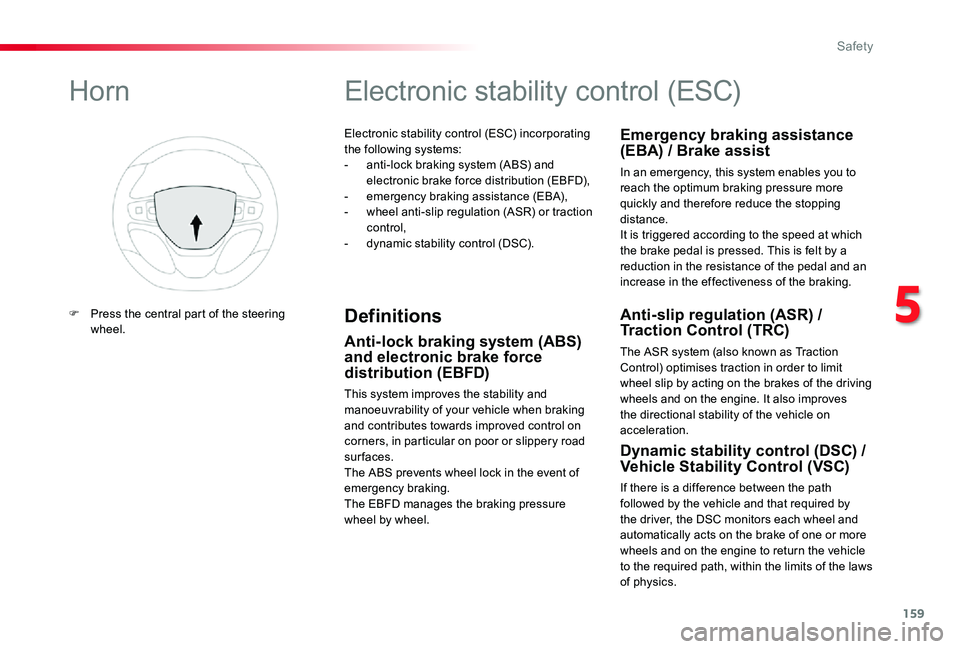
159
ER A - GLONASS
emergency call system*Electronic stability control (ESC) incorporating the following systems:- anti-lock braking system (ABS) and electronic brake force distribution (EBFD),- emergency braking assistance (EBA),- wheel anti-slip regulation (ASR) or traction control,- dynamic stability control (DSC).
Electronic stability control (ESC)
Definitions
Anti-lock braking system (ABS) and electronic brake force distribution (EBFD)
This system improves the stability and manoeuvrability of your vehicle when braking and contributes towards improved control on corners, in particular on poor or slippery road surfaces.The ABS prevents wheel lock in the event of emergency braking.The EBFD manages the braking pressure wheel by wheel.
Emergency braking assistance (EBA) / Brake assist
In an emergency, this system enables you to reach the optimum braking pressure more quickly and therefore reduce the stopping distance.It is triggered according to the speed at which the brake pedal is pressed. This is felt by a reduction in the resistance of the pedal and an increase in the effectiveness of the braking.
Anti-slip regulation (ASR) / Traction Control (TRC)
The ASR system (also known as Traction Control) optimises traction in order to limit wheel slip by acting on the brakes of the driving wheels and on the engine. It also improves the directional stability of the vehicle on acceleration.
Dynamic stability control (DSC) / Vehicle Stability Control (VSC)
If there is a difference between the path followed by the vehicle and that required by the driver, the DSC monitors each wheel and automatically acts on the brake of one or more
wheels and on the engine to return the vehicle to the required path, within the limits of the laws of physics.
Horn
F Press the central part of the steering wheel.
5
Safety
Page 167 of 418
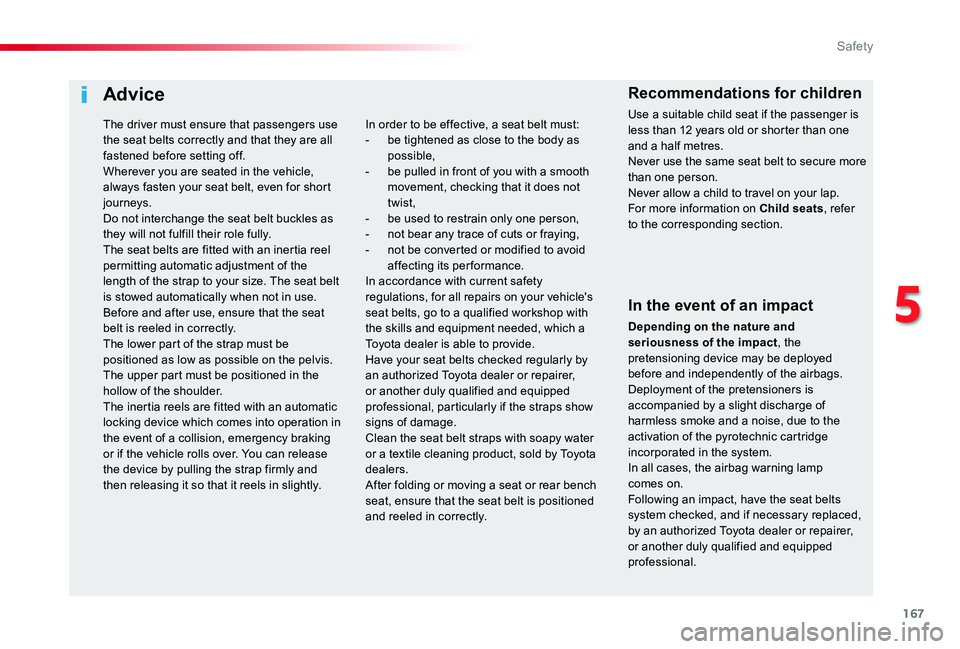
167
Advice
In the event of an impact
Depending on the nature and seriousness of the impact, the pretensioning device may be deployed before and independently of the airbags. Deployment of the pretensioners is accompanied by a slight discharge of harmless smoke and a noise, due to the activation of the pyrotechnic cartridge incorporated in the system.In all cases, the airbag warning lamp comes on.Following an impact, have the seat belts system checked, and if necessary replaced, by an authorized Toyota dealer or repairer, or another duly qualified and equipped professional.
In order to be effective, a seat belt must:- be tightened as close to the body as possible,- be pulled in front of you with a smooth movement, checking that it does not twist,- be used to restrain only one person,- not bear any trace of cuts or fraying,- not be converted or modified to avoid affecting its performance.In accordance with current safety regulations, for all repairs on your vehicle's seat belts, go to a qualified workshop with the skills and equipment needed, which a Toyota dealer is able to provide.Have your seat belts checked regularly by an authorized Toyota dealer or repairer, or another duly qualified and equipped professional, particularly if the straps show signs of damage.Clean the seat belt straps with soapy water or a textile cleaning product, sold by Toyota dealers.After folding or moving a seat or rear bench seat, ensure that the seat belt is positioned and reeled in correctly.
Recommendations for children
Use a suitable child seat if the passenger is less than 12 years old or shorter than one and a half metres.Never use the same seat belt to secure more than one person.Never allow a child to travel on your lap.For more information on Child seats, refer to the corresponding section.
The driver must ensure that passengers use the seat belts correctly and that they are all fastened before setting off.Wherever you are seated in the vehicle, always fasten your seat belt, even for short journeys.Do not interchange the seat belt buckles as they will not fulfill their role fully.The seat belts are fitted with an inertia reel permitting automatic adjustment of the length of the strap to your size. The seat belt is stowed automatically when not in use.Before and after use, ensure that the seat belt is reeled in correctly.The lower part of the strap must be positioned as low as possible on the pelvis.The upper part must be positioned in the hollow of the shoulder.The inertia reels are fitted with an automatic locking device which comes into operation in the event of a collision, emergency braking or if the vehicle rolls over. You can release the device by pulling the strap firmly and then releasing it so that it reels in slightly.
5
Safety
Page 168 of 418
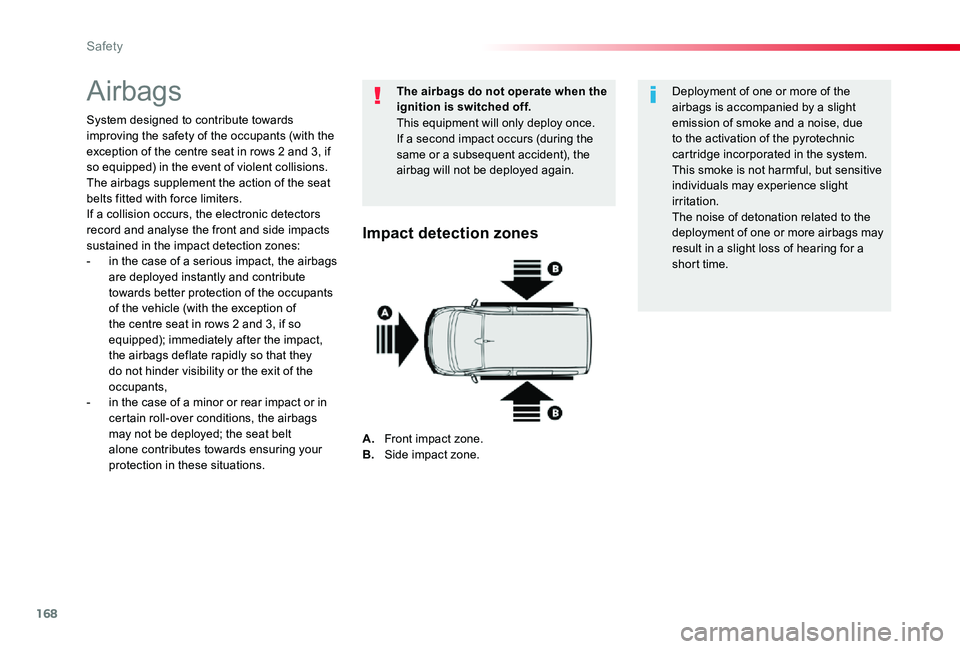
168
Airbags
System designed to contribute towards improving the safety of the occupants (with the exception of the centre seat in rows 2 and 3, if so equipped) in the event of violent collisions. The airbags supplement the action of the seat belts fitted with force limiters.If a collision occurs, the electronic detectors record and analyse the front and side impacts sustained in the impact detection zones:- in the case of a serious impact, the airbags are deployed instantly and contribute towards better protection of the occupants of the vehicle (with the exception of the centre seat in rows 2 and 3, if so equipped); immediately after the impact, the airbags deflate rapidly so that they do not hinder visibility or the exit of the occupants,- in the case of a minor or rear impact or in certain roll-over conditions, the airbags may not be deployed; the seat belt
alone contributes towards ensuring your protection in these situations.
The airbags do not operate when the ignition is switched off.
This equipment will only deploy once. If a second impact occurs (during the same or a subsequent accident), the airbag will not be deployed again.
Deployment of one or more of the airbags is accompanied by a slight emission of smoke and a noise, due to the activation of the pyrotechnic cartridge incorporated in the system.This smoke is not harmful, but sensitive individuals may experience slight irritation.The noise of detonation related to the deployment of one or more airbags may result in a slight loss of hearing for a short time.
Impact detection zones
A. Front impact zone.
B. Side impact zone.
Safety
Page 170 of 418
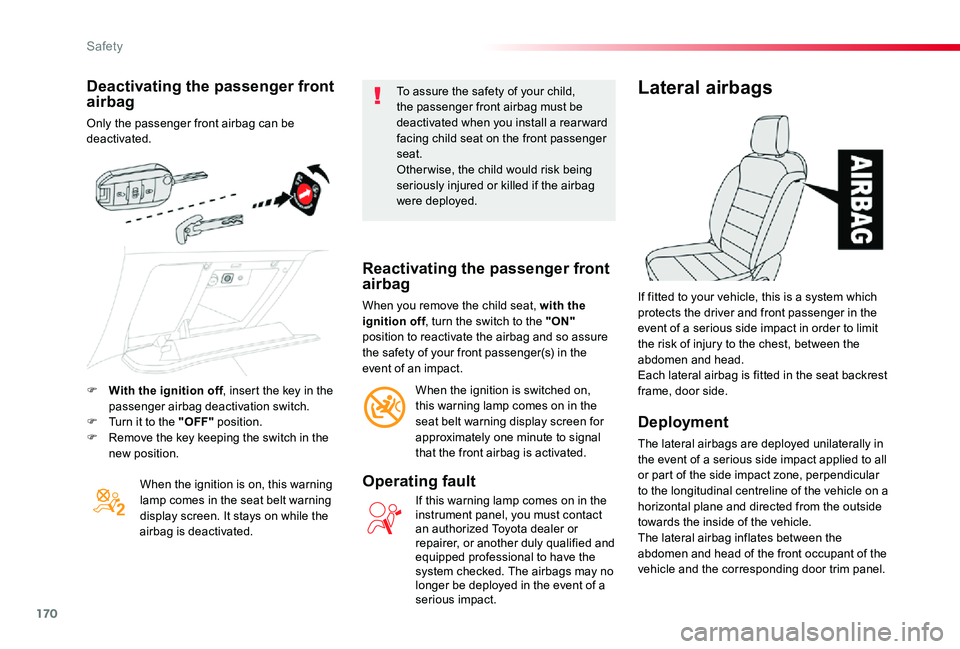
170
Deactivating the passenger front airbag
Only the passenger front airbag can be deactivated.
When the ignition is on, this warning lamp comes in the seat belt warning display screen. It stays on while the airbag is deactivated.
To assure the safety of your child, the passenger front airbag must be deactivated when you install a rear ward facing child seat on the front passenger seat.Other wise, the child would risk being seriously injured or killed if the airbag were deployed.
Reactivating the passenger front airbag
When you remove the child seat, with the ignition off, turn the switch to the "ON" position to reactivate the airbag and so assure the safety of your front passenger(s) in the event of an impact.
When the ignition is switched on, this warning lamp comes on in the seat belt warning display screen for approximately one minute to signal that the front airbag is activated.
Operating fault
If this warning lamp comes on in the instrument panel, you must contact an authorized Toyota dealer or repairer, or another duly qualified and equipped professional to have the system checked. The airbags may no longer be deployed in the event of a serious impact.
Lateral airbags
Deployment
The lateral airbags are deployed unilaterally in
the event of a serious side impact applied to all or part of the side impact zone, perpendicular to the longitudinal centreline of the vehicle on a horizontal plane and directed from the outside towards the inside of the vehicle.The lateral airbag inflates between the abdomen and head of the front occupant of the vehicle and the corresponding door trim panel.
If fitted to your vehicle, this is a system which protects the driver and front passenger in the event of a serious side impact in order to limit the risk of injury to the chest, between the abdomen and head.Each lateral airbag is fitted in the seat backrest frame, door side.F With the ignition off, insert the key in the passenger airbag deactivation switch.F Turn it to the "OFF" position.F Remove the key keeping the switch in the
new position.
Safety
Page 171 of 418

171
If fitted to your vehicle, this is a system that contributes towards greater protection for the passengers (with the exception of the centre seats) in the event of a serious side impact in order to limit the risk of injury to the side of the head.Each curtain airbag is built into the pillars and the upper passenger compartment area.
Deployment
In the event of a minor impact or bump on the side of the vehicle or if the vehicle rolls over, the airbags may not be deployed.In the event of a rear or front collision, none of the lateral airbags is deployed.
If this warning lamp comes on in the instrument panel, you must contact an authorized Toyota dealer or repairer, or another duly qualified and equipped professional to have the system checked.
Operating fault
Curtain airbags (row 2 and 3)
The airbags may no longer be deployed in the
event of a serious impact.
The curtain airbag is deployed in the event of a serious side impact applied to all or part of the side impact zone B, perpendicular to the longitudinal centreline of the vehicle on a horizontal plane and directed from the outside towards the inside of the vehicle.The curtain airbag inflates between the outer rear occupant of the vehicle and the windows.
5
Safety
Page 182 of 418
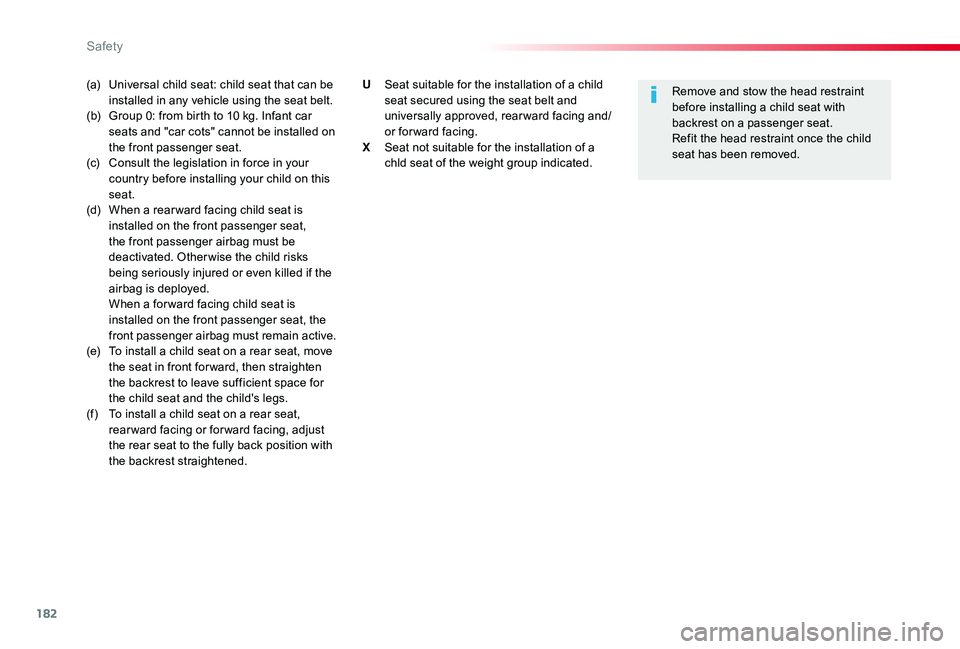
182
(a) Universal child seat: child seat that can be installed in any vehicle using the seat belt.(b) Group 0: from birth to 10 kg. Infant car seats and "car cots" cannot be installed on the front passenger seat.(c) Consult the legislation in force in your country before installing your child on this seat.(d) When a rear ward facing child seat is installed on the front passenger seat, the front passenger airbag must be deactivated. Other wise the child risks being seriously injured or even killed if the airbag is deployed. When a for ward facing child seat is installed on the front passenger seat, the front passenger airbag must remain active.(e) To install a child seat on a rear seat, move the seat in front for ward, then straighten the backrest to leave sufficient space for the child seat and the child's legs.(f) To install a child seat on a rear seat, rear ward facing or for ward facing, adjust the rear seat to the fully back position with the backrest straightened.
Remove and stow the head restraint before installing a child seat with backrest on a passenger seat.Refit the head restraint once the child seat has been removed.
U Seat suitable for the installation of a child seat secured using the seat belt and universally approved, rear ward facing and/or forward facing.X Seat not suitable for the installation of a chld seat of the weight group indicated.
Safety
Page 183 of 418
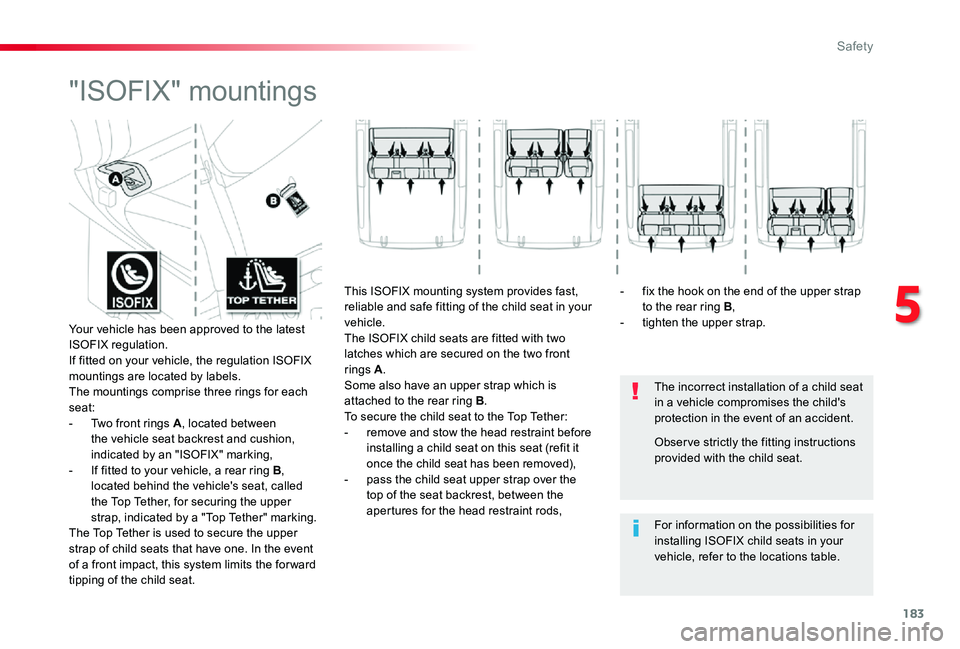
183
"ISOFIX" mountings
The incorrect installation of a child seat in a vehicle compromises the child's protection in the event of an accident.
For information on the possibilities for installing ISOFIX child seats in your vehicle, refer to the locations table.
Obser ve strictly the fitting instructions provided with the child seat.
Your vehicle has been approved to the latest ISOFIX regulation.If fitted on your vehicle, the regulation ISOFIX mountings are located by labels.The mountings comprise three rings for each seat:- Two front rings A, located between the vehicle seat backrest and cushion, indicated by an "ISOFIX" marking,- If fitted to your vehicle, a rear ring B, located behind the vehicle's seat, called the Top Tether, for securing the upper strap, indicated by a "Top Tether" marking.The Top Tether is used to secure the upper
strap of child seats that have one. In the event of a front impact, this system limits the for ward tipping of the child seat.
This ISOFIX mounting system provides fast, reliable and safe fitting of the child seat in your vehicle.The ISOFIX child seats are fitted with two latches which are secured on the two front rings A.Some also have an upper strap which is attached to the rear ring B.To secure the child seat to the Top Tether:- remove and stow the head restraint before installing a child seat on this seat (refit it once the child seat has been removed),- pass the child seat upper strap over the top of the seat backrest, between the apertures for the head restraint rods,
- fix the hook on the end of the upper strap to the rear ring B,- tighten the upper strap.
5
Safety